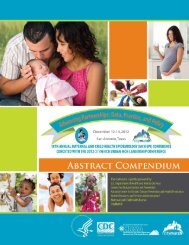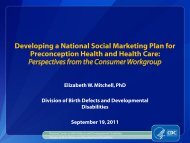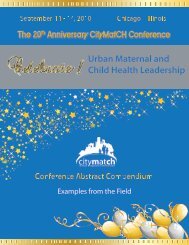Conference Abstract Compendium Examples from the ... - CityMatCH
Conference Abstract Compendium Examples from the ... - CityMatCH
Conference Abstract Compendium Examples from the ... - CityMatCH
Create successful ePaper yourself
Turn your PDF publications into a flip-book with our unique Google optimized e-Paper software.
2009 <strong>CityMatCH</strong> Urban MCH Leadership <strong>Conference</strong>A prematurity education program for home health care providersPRIMARY CONTACT:Sara J Paton, PhD, MS, BSEpidemiologistWright State Univeristy3123 Research Blvd Suite 200Kettering, OH, 45420Phone: (937) 258-5553Fax: (937) 258-5544Email: sara.paton@wright.eduCATEGORYPreconception health and health carePrematurity / Preterm birth / BirthweightFOCUSData FocusCO-PRESENTER(S)/AUTHOR(S):Lisa Jasin, ljasin@yahoo.com (Author,Presenter)Mary Ann Swank,SwankM@childrensdayton.org (Author)BACKGROUNDPrematurity is a growing problem in <strong>the</strong> United States with one in eight babies being born before 37weeks of gestation. Prematurity is <strong>the</strong> leading cause of neonatal mortality, and is <strong>the</strong> number one cause ofinfant mortality in non-Hispanic black infants. Many home health care programs in <strong>the</strong> Dayton, Ohioregion visit women with risk factors for premature birth. In order to assess what education <strong>the</strong> homehealth care providers were providing clients about prematurity a survey of home health care providers wasconducted in 2005. Results indicated that only 28.6% of home health care providers had <strong>the</strong> standardpractice of discussing preterm delivery with a woman with a prior preterm delivery. In addition, only 52%of respondents felt <strong>the</strong>y had <strong>the</strong> expertise to counsel women regarding preterm delivery and 46% felt thatthis lack of expertise was <strong>the</strong> largest barrier to counseling. When asked what information would be mostuseful in educating women about preterm delivery, 53% reported that educational materials would behelpful and 33% reported continuing education would be helpful.OBJECTIVESThe objective of this project is to increase <strong>the</strong> education of home health care providers working withwomen at risk for premature birth. The education emphasizes modifiable risk factors and strategies toavoid premature birth. The overall aim of <strong>the</strong> project is to decrease prematurity in <strong>the</strong> Dayton, Ohioregion.METHODSA PowerPoint presentation <strong>from</strong> <strong>the</strong> March of Dimes was presented to home health care workers on <strong>the</strong>epidemiology and biology of preterm birth. Pre and post intervention surveys were given to assess if <strong>the</strong>intervention increased awareness of modifiable risk factors associated with prematurity and increasedcomfort level of discussing preterm delivery with clients. Prevalence of survey answers were calculatedand used to compare differences in means of answers in pre and post surveys.109







